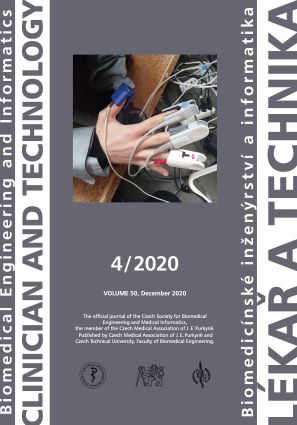UPGRADE OF THE LANGENDORFF APPARATUS USING THE INFRARED THERMO-CONTROL SYSTEM AND AN INTELLIGENT HEATER
DOI:
https://doi.org/10.14311/CTJ.2020.4.03Abstract
Biological experiments involving isolated organs and tissues demand precise temperature monitoring and regulation. An automatic temperature control system was proposed and optimised on real isolated swine hearts and the prototype is described in this work. The traditional Langendorff apparatus consists of a heart holder, a reservoir of perfusion solution flowing to aortic cannula and a heating bath allowing passive heat transfer to the reservoir of perfusion solution. The commercial infrared camera FLIR T62101 was added to this basic set-up and used for very precise monitoring of the temperature kinetic of the organ and connected with an electronic feedback loop, which allowed real-time and precise regulation of heat transfer from the heating bath to the perfusion solution and in turn indirectly to the heart tissue. This provides real time control and active regulation of the myocardial tissue temperature. The infrared camera was tested in several modes and several variants of detection were optimised for ideal measurement of the region of interest of the ex vivo organ. The kinetics of the temperature changes and temperature stability of the tissue were recorded and calibrated by external electronic thermometers (type Pt100, inserted in tissue). The time lapse from the hang-up of the hypo termed organ (30 °C) until optimal warming (37 °C) was less than eight minutes in the final instrument prototype. The final stability of the 37 °C tissue temperature was approved; the temperature fluctuation of left ventricle tissue was characterised as 36.8 ± 0.5 °C. This upgraded traditional instrument could be used in specific preclinical and clinical transplantation and analytical projects in future.
Downloads
Published
Issue
Section
License
Copyright (c) 2021 Josef Skopalík, Jiří Sekora, Martin Pešl , Markéta Bébarová , Olga Švecová , Tomáš Parák , Vratislav Čmiel , Ivo Provaznik , Edita Jeklová , Josef Mašek

This work is licensed under a Creative Commons Attribution 4.0 International License.
Authors who publish with this journal agree to the following terms:
- Authors retain copyright and grant the journal right of the first publication with the work simultaneously licensed under a Creative Commons Attribution License (https://creativecommons.org/licenses/by/4.0/) that allows others to share the work with an acknowledgment of the work's authorship and initial publication in CTJ.
- Authors are able to enter into separate, additional contractual arrangements for the non-exclusive distribution of the journal’s published version of the work (e.g., post it to an institutional repository or publish it in a book), with an acknowledgment of its initial publication in this journal.
- Authors are permitted and encouraged to post their work online (e.g., in institutional repositories or on their website or ResearchGate) prior to and during the submission process, as it can lead to productive exchanges.
CTJ requires that all of the content of the manuscript has been created by its respective authors or that permission to use a copyrighted material has been obtained by the authors before submitting the manuscript to CTJ. CTJ requires that authors have not used any copyrighted material illegally, as for example a picture from another journal or book, a photo, etc. It is the author’s responsibility to use only materials not violating the copyright law. When in doubt, CTJ may ask the authors to supply the pertinent permission or agreement about the use of a copyrighted material.
The opinions expressed in CTJ articles are those of authors and do not necessarily reflect the views of the publishers or the Czech Society for Biomedical Engineering and Medical Informatics.


